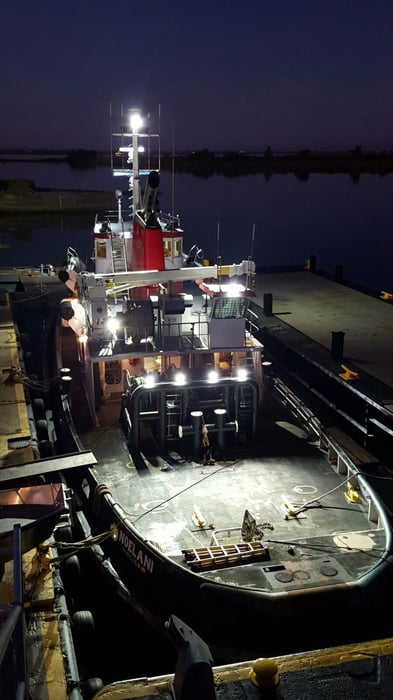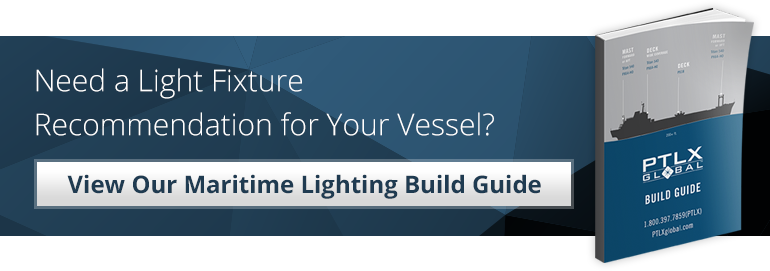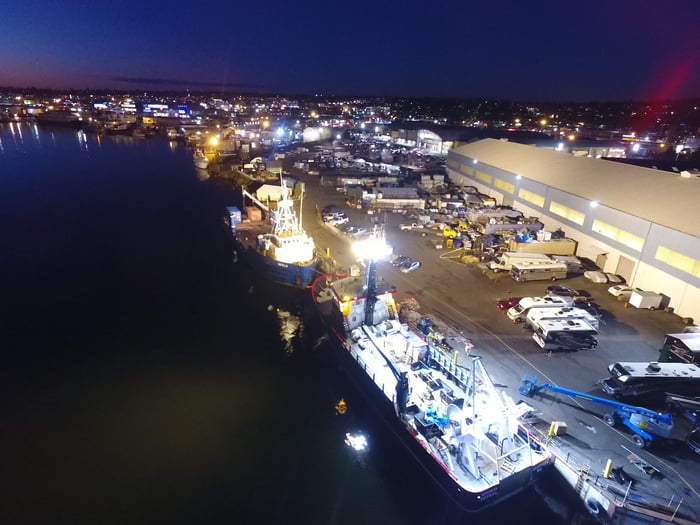
Table of Contents
Over the past 4 years we’ve worked within the Marine/Maritime sector providing lighting 'solutions' to a multitude of vessel applications. It has been a learning experience, and obviously the more boats we did the more we learned what worked well and what really didn’t.
We’ve also worked with some really smart engineer’s, electricians and maintenance folks who helped us see a lot of what we, on the fixture side, don’t always see. We've outfitted everything from Processors to Pilot boats, Charter boats to Tug and Barge; and every classification of vessel offers different parameters for proper exterior lighting.
As the advent of LED makes its way across more and more Marine/ Industrial applications, and with a lot of experience in working with LED across these segments, there are Five big things that we’ve seen that influence the outcomes of LED performance in Maritime applications that improves illumination levels, reduces glare or 'flashback' and remedies for dark spots or operator areas where lighitng is limited. We also hope to address some of the big mistakes we've seen in exterior Marine lighting applications and ways in which boat owners and Captain's can properly improve illumination challenges without crappy outcomes.
- Placement
- Orientation
- Color
- Type
- AC/DC voltage
Placement
The biggest factor for improved illuminated work areas is placement. Most often Marine fixtures are replaced on an ad-hoc basis; light goes out, next trip in – swing by the distributor and grab an ‘LED’ replacement fixture; hopefully more durable than the fixture being replaced - no bulbs or ballasts. Often, placement is defaulted to where the traditional fixture is located, and often times we see the wrong type LED fixture is installed. None the wiser, most LED replacements will initially provide a lot of bright light and be an ‘improvement’ to the older traditional fixture that was replaced. Frankly, in the end it doesn’t matter whose LED light fixture you have, poor light placement with the wrong fixture can create issues, even safety problems.
With light fixture placement most often relegated to the initial design mounts, and most often with older, ‘traditional’ fixtures (Halogen, Metal Halide, HPS), making the change to LED can dramatically influence the illumination characteristics, but not always for the better. If the fixture placement is pre-determined and is difficult to influence (can’t be easily changed due to wiring, mounts or physical limitations) than finding an LED product that can be influenced (color, beam pattern) is really important - placement challenges can be positively influenced by the right LED fixture configuration. For example, using an LED deck light that is 5500+ Kelvin 10-15' off the deck will provide alot of light (depending on the fixture, wattage, etc) but has also proven to be overly aggressive with glare and reflection over a prolonged periods of light exposure. Also, irrespective of the LED fixture used, it's unlikely that an LED unit is going to provide the same 'apples to apples' illumination characteristics with that of the replaced traditional fixture. The objective with changing fixtures to LED, besides its maintenance free characteristics, is to improve overall illumination levels effectively, safely, and not just simply replace what was previously used to plug the mounting bracket.
It is unwise of a manufacturer or sales rep to make assertions to the right replacements based on wattage equivalencies (140W LED = 400W Metal Halide) without first understanding (seeing) the layout of the lights to the vessel, or feedback from the Captain or other operators. We’ve made slight adjustments to placements that have had a dramatic effect to the Captain’s visibility and deck illumination by physically seeing the vessels layout.
Orientation
...is quite frankly, a bi-product of placement. Using existing placement, orientation is strongly influenced by the beam pattern and color temperature associated with the fixture. In new boat design, orientation can be one of the most important elements to improving illumination levels and providing a safer, more effective work environment. For fishing vessels, orientation can remedy the darker areas on deck that are created by the boom crane or other type equipment. Simply due to LED hemisperical design, and its embedded durability with having no bulbs or ballasts, LED fixtures can provide directed lighting to areas that were once difficult to achieve with traditional Halogen, HPS, MH fixtures.
Conversely, poor orientation is problematic. We've seen this, most often, coupled with a poor placement and higher (Color Correlated Temperature) color units making the overall illumination characteristics very challenging. We know many Captain's that resist the change to LED for these very reasons and it's because Marine lighting fixture choices and installation is taken without the same prudence and thought that an architect will likey give to lighting a simple office space. Yet the office space isn't on the open waters where inadequate illumination can cause accidents and even cost lives. The first question of orientation is:
- Will the projected light meet the natural line of sight of the operator(s)?
- If it does, can the fixture be repositioned?
- If not, can another fixture not in the line of sight be used to make up the illumination for the fixture(s) that do, so that the fixtures that are can be oriented to another (task) area?
- If none of these are options then Color or CCT of the fixture needs to be addressed.
Color
LED lights vary across the spectrum of light and are labeled using Color Correlated Temperature (CCT) and are measured in Kelvin (K). The higher the Kelvin temperature the more bluish white the fixture is perceived. The lower the CCT or Kelvin the warmer or more yellow the light will be perceived. Typical ranges for most traditional (non-colored) LED fixtures is @ 2700 CCT to @ 6000 CCT. The challenges to providing 'proper' LED illumination with poor placement and orientation is exacerbated by higher Kelvin temperature fixtures. The use of higher Kelvin temperature fixtures need to be used and orientated properly otherwise the issues of glare or 'flashback,' in fog or snow, can seriously impede visibility. In addition, cooler temperature fixtures, while initially present an abundance of illumination, can over time become aggressive to the operators over longer shift periods**.
**The topic of Scotopic and Photopic lumens is an area of discussion that we'll address for brevity sake in another Blog article. Briefly, how we perceive colors of light differ depending on the ambient light environment and the color temperature of the fixtures being used.
Type
When we refer to 'type' of fixture we refer less to the illumination characteristics as to the design of the fixture and how different design types offer better options in different applications. Essentially, there are four types of fixtures:
- LED fixtures with built-in driver (non field replaceable driver)
- LED fixtures with built-in driver (field replaceable driver)
- LED fixture with bracket mount driver
- LED fixture with remotely mounted driver
There are very few manufacturers with whom we know use an in-house custom designed driver, we happen to be one of them. This type of driver is typically not field replaceable but the driver is designed to last much longer than a traditional sub-assembly driver (such as Meanwell, Philips Advance etc) With this type of fixture, if the fixture fails another fixture is needed. No field maintenance is needed with this type of fixture.
LED fixtures with field replaceable drivers are becoming more common-place especially within commercial applications. The upside to this type fixture is that the driver can be accessed within the fixture and technically be changed out with a new driver. Where issues exists, especially in Marine applications, is if the fixtures is located where it is difficult, even unsafe to access; or ingress protection is compromised once the driver is accessed or replaced with a new driver. To avail oneself the advantage of this type fixture it is best to keep an additional driver(s) on board in case of fixture failure. Field replacement is obviously mitigated by the operating conditions under which the vessel is in and/or where the fixture is located on the vessel.
LED fixtures with bracket mount driver may provide easier access to the driver given the fixture does not need to be opened to access the driver. However, if the fixture is still located in an area where its challenging or down-right unsafe to get to, driver access is a moot point. Additionally, ensure the ingress protection to the driver has not been compromised when accessed.
LED fixture with remotely mounted drivers we're hoping gain more popularity. We've used this design set-up with one of our oldest and best Tug and Barge customers and it provides for the safest and most effective replacement set-up of all fixture options. Considering a 110V system running lights off the generator, the LED fixtures would be low voltage DC units (24VDC) using a remote driver mounted in the engine room or the house of the vessel. Line loss using a fixture with enough nominal voltage range is negligable and driver access is immediate, risk-free and doesn't add additional weight at higher points of the vessel . Consider the Tug and Barge company, uses 2 high powered 29,000 lumen, 24VDC LED flood fixtures running 60', 12 gauge cable to their engine room where the drivers are remotely mounted to the wall. Each end of the driver (AC and DC line) uses a deutsch plug connector, so if there is a driver failure the old to the new driver can be switched out in a few minutes with no safety risk. This leads to the fifth factor in outdoor Marine Lighting - AC/DC voltage.
AC/DC Voltage
Using a remote mounted driver may be a very effective mechanism in managing for driver access in environments and mounting locations that are very difficult to access. However, practicality of running new wire from fixture to driver may make this set-up onerous depending on where the fixtures are located. That said, for deck or under-deck applications developing a 'zone' system with low wattage LED fixtures tapped into one AC driver creates a redundancy tool in the setup. If the driver fails all fixtures wired to that driver will go out; not ideal, but operators know where the failure exists and where the driver is located for quick and easy replacement. With the zone concept drivers can be located behind specifically located weather-proof boxes (for larger deck applications) or inside, and tagged similar to a breaker panel. A fishing vessel for example may have a dozen zones for lighting applications; wheras a Pilot boat may only have a few.
Currently, the majority of LED fixtures are installed as replacements and that means they are most often wired into an AC voltage system. When you're changing out the unit give some thought to its location (Placement), where is the illumination going (Orientation) and will this increase glare? If so, think to ask for a Neutral white fixture (4000-4500 Color).
Our thoughts are: the Industrial environment (Maritime, Mining, Heavy Contruction, etc.) deserve as much, if not more attention to effective and appropriate illumination as does the immune office building. Yet there are very few practitioners in this space that believe there is more to lighting than simple wattage equivalency replacements.
Please feel free to contact us with any questions, or are interested in a lighting set-up evaluation. Sales@ptlxglobal.com 800.397.7859





